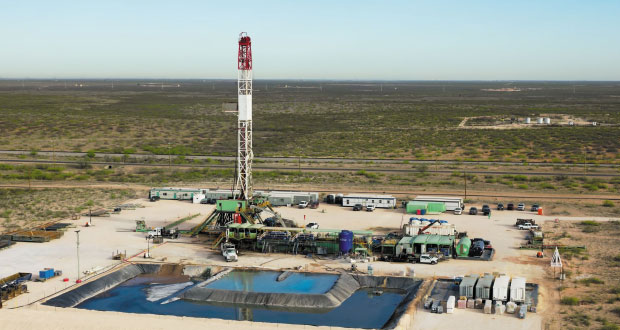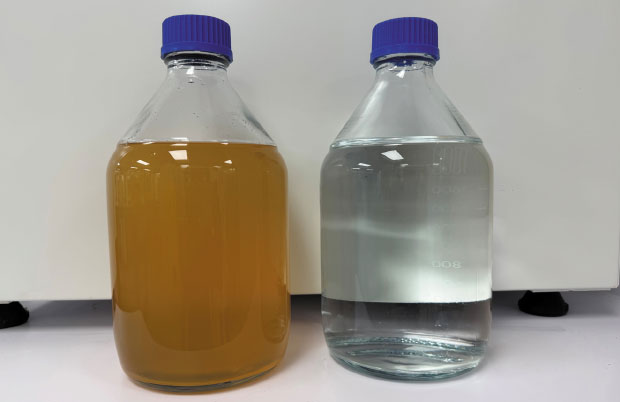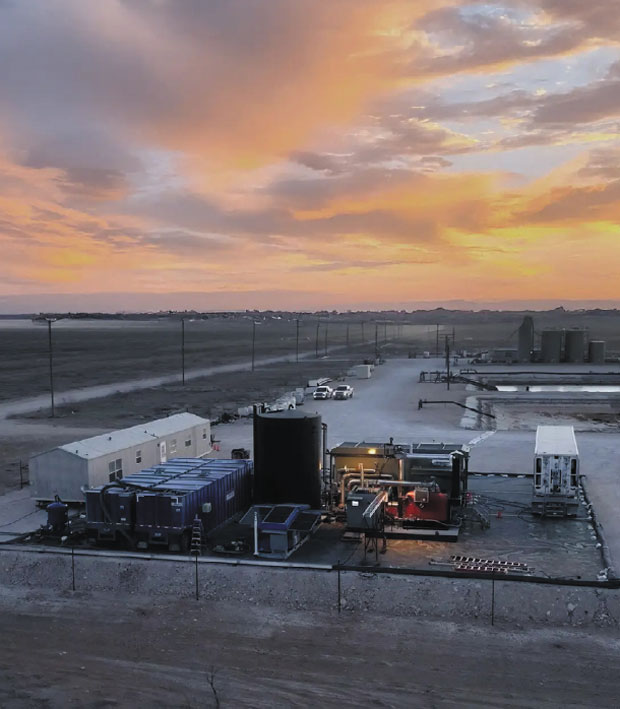
Industry Makes Progress On Turning Produced Water Into Much-Needed Resource
By Andrew Linnabary
ODESSA, TX.—Many Permian Basin wells produce five or more barrels of water for every barrel of oil. In aggregate, they bring more than 20 million barrels of produced water to surface every day. For context, that is enough to fill 1,270 Olympic swimming pools. For years, the solution seemed simple: pipe the water to a saltwater disposal well and inject it underground.
But today, disposal capacity can no longer keep pace with growing produced water volumes. According to several produced water experts, these changes and the urgency surrounding Texas water, as well as water resources at home and abroad, have reframed the conversation. Instead of asking, “where do we put the water,” the industry is asking, “how do we reuse it, recycle it, and convert it into a resource?”
That includes recycling water within the industry, or for use in agriculture, or other industries where it’s needed. To put it simply, water is the base ingredient in improving people’s lives.
A Necessary Change
Few understand the scope of the challenge as well as Patrick Patton, vice president of product at B3 Insight. His company specializes in following water through an asset’s lifecycle.
“We track water production, water injection, recycling, source water—more or less every molecule of water in the oil field,” Patton says. “We’re recognized as kind of the gold standard for water-related data in oil field water management.”
While drilling and completion sites in both Texas and New Mexico increasingly use produced water for tasks that once required freshwater, that still leaves plenty of produced water that needs to be injected into saltwater disposal wells or put to work in other ways, B3 Insight observes. As produced water volumes continue to rise and strain SWD capacity, the company says it is expanding its extensive data on water volumes, disposal trends and reuse opportunities and creating forecasting tools that will help companies identify the best locations for water pipelines and treatment facilities.
Patton remembers when the issue began to draw serious attention. “Around 2016, operators like Anadarko realized that if they forecasted their development plans, the volumes of produced water were going to be enormous,” he says. “That was when attention ramped up, and dedicated water management companies started forming.”
By 2019, deep disposal volumes triggered a different problem, Patton says: earthquakes. “The Railroad Commission stepped in,” Patton recalls. “They drew seismic response areas around epicenters and started curtailing volumes. That mitigated the largest events, but the water still had to go somewhere.”
The short-term answer was shallow injection, but that fix has limits, Patton says. “Think of the injection zone like a balloon,” Patton says. “You keep putting water into it, and it gets harder to put the next drop in. Pressure builds, costs rise. That’s why transporting water long distances for disposal or treating it for reuse are now being taken seriously.”
Economics magnify the water management challenge. With water to oil ratios so steep, even a small increase in disposal costs cascades through well economics, Patton says.
But there has been progress on other solutions. Patton notes recycling’s quick rise. “In the Permian, recycled produced water used in completions has gone from between 10% and 15% a few years ago to around 70% today,” Patton reports. “That’s applaudable. It’s one of the basin’s big success stories, but it doesn’t solve everything.”
Even with today’s intense frac designs, wells generate more water than completion crews can send back to the subsurface, Patton explains. To truly address the water problem, he says, the basin must embrace beneficial use beyond frac jobs.
“We can almost think of produced water as new,” he suggests. “It’s water that’s trapped a mile-and-a-half or two miles deep that’s out of the hydraulic cycle to begin with. So, we are bringing to the surface millions of barrels per day of water that was not in the hydraulic cycle. It’s salty and it needs to be treated, but we are bringing new water into an arid desert.
“This water is a byproduct, but out here in the desert, I’d call it a commodity.”
To capitalize on that commodity, the industry will need to invest in pipelines and treatment facilities capable of preparing the water for reuse and getting it to market, Patton notes. He emphasizes that anticipating future needs and planning ahead will be essential to building cost-effective infrastructure.
With that in mind, Patton says B3 has developed an extensive pressure database for the region and is also focused on developing an AI-powered forecasting system. “We’re building a tool that will forecast, at the basin and well level, when and where water will be produced, along with injection and disposal capacity, to better understand the range of future outcomes for the Permian.
“Where are our pinch points? Where do we need more alternative solutions? Where do we have injection capacity? Where don’t we?” Patton poses. “To answer those questions, we’re really leaning into the predictive space and utilizing all these new tools that are becoming available.”
From Waste to Resource
Michael Grossman, technical committee chair for the Produced Water Society, says that progress hinges on reframing how the industry and the public think about produced water.
“This is a new water source,” Grossman says. “Produced water wasn’t previously accessible in the hydrologic cycle. West Texas farmers, for example, can essentially get access to water that wasn’t available to them before now.”
Farmers are far from the only ones eager for a reliable water supply, Grossman observes. With proper treatment, he says produced water could also be used by manufacturers, power generators and data centers.
To reinforce the water’s value, Grossman encourages the industry to move away from referring to produced water applications as “reuse.” “Traditional reuse is about cleaning up wastewater you generated and using it again,” he explains. “Produced water is different. This is water that was locked away for geologic time.”
To describe situations where companies put that water to work rather than merely disposing of it, Grossman recommends calling it “beneficial use.”
From a purely technical standpoint, beneficial use has been possible for a long time. “We’ve had desalination for decades,” Grossman says. “The issue has always been economics and regulation. Costs have come down, and Texas has clarified ownership and liability. Those changes have opened the door to explore produced water use outside the industry.”
The right legislation and regulations will be key to enabling widespread viability, Grossman says. He highlights the divergence between Texas and New Mexico. “The Texas Supreme Court ruled that the mineral rights owner owns the produced water, saying it’s part of their oil and gas extraction rights unless a lease specifically assigns ownership elsewhere,” he says. “New Mexico, on the other hand, is a lot murkier. The state’s Water Quality Control Commission ruled there is no safe use of treated produced water outside oil and gas. That leaves it several years behind Texas in that regard.”
In states with supportive regulatory frameworks, the industry is embracing beneficial use, Grossman reports.
“In my personal opinion, the first major produced water projects in the Permian Basin will happen within the next year,” he predicts. “Within five years I think there will be substantial scale, to the level of hundreds of thousands if not a million plus barrels a day. And 10 years from now, we’ll be taking a significant fraction of the water, to the order of millions of barrels. So, that’s my hope.”
Linking Supply and Demand
To maximize produced water use both inside and outside the industry, operators and end users will need easy ways to connect, says Barry Barksdale, president of PDS Energy Information. His company, which already provides a platform that makes it easy for operators to share their frac schedules with each other so they can avoid interference, has adapted its technology to water management.
“With our water platform, the idea is simple,” Barksdale explains. “Instead of immediately routing excess produced water to a saltwater disposal well, operators can post availability on the platform. If a neighbor needs 50,000 barrels for a frac, they can use that instead of freshwater.”
That is valuable for operators of any size. “The big guys already reuse water internally to some extent,” Barksdale acknowledges. “But schedules change. If a well is delayed and you suddenly don’t have a home for 25,000 barrels, making those barrels visible on our platform means someone else can take them off your hands.”
Finding better ways to manage water is becoming urgent, Barksdale says. “Conservatively, people estimate five to 10 years before Midland-Odessa runs into real freshwater shortages. Cities and legislators are already having serious meetings about it,” he says. “They know they need to plan ahead to keep the problem from snowballing out of control.”
By simplifying produced water transactions, Barksdale says PDS Energy aims to reduce strain on freshwater supplies.
“We’ve seen how markets can solve problems,” he adds. “The moment people can see value, they treat it differently. If we can help make produced water a tradable asset—something companies can post, buy, sell, and move around—that changes behavior at every level.”
He stresses that cooperation is no longer optional. “It’s not just about one operator’s wells anymore. Produced water is a basin-wide challenge. If your neighbor has a problem, you have a problem. This system is about making those connections visible.”
Economic Desalination
Before produced water can be beneficially used for industrial purposes, or for augmenting surface waters or aquifers, it must be treated to exacting standards to ensure environmental safety. This treatment includes removal of suspended solids, chemicals and dissolved organics and salts. The salt removal—or desalination—of the produced water is, by far, the biggest challenge given produced waters’ extreme salt content. For highly saline water, traditional desalination technologies are prohibitively expensive and do not scale to the large volumes of produced water generated in the Permian Basin, says Earl Jones, executive chairman of Aquafortus.
Transforming produced water from a waste stream into a valuable commodity requires cost-effective techniques for removing salt and other concerns. Aquafortus says its desalination technology, which turned the produced water sample on the left into the clean water on the right, is so affordable that it can make desalinating and repurposing produced water less expensive than disposal.
“At 120,000 parts per million total dissolved solids, which is nearly four times saltier than seawater, membrane desalination does not work,” Jones says. “Thermal evaporation solutions work technically at these salinities, but they are expensive and cannot realistically scale to hundreds of thousands of barrels per day, which is the scale needed to be meaningful for the oil and gas and mining industries.”
Aquafortus, whose investors include the “deep tech” venture capital firm DCVC, offers a different approach. “At its core, Aquafortus uses chemistry for desalination. The Aquafortus process mixes produced water with a proprietary non-toxic, non-flammable chemical we call our absorbent. Think of the absorbent as a liquid sponge,” Jones says. “Our absorbent is special because it has a high affinity for water, but most importantly, rejects everything else in the brine, creating an effective water separation that pulls out clean water while leaving the salts and chemicals behind.
“Once the absorbent is saturated, our process transfers the absorbed water to a second chemical that we call our regenerant, which is a food-grade chemical. The regenerant releases, or regenerates, the absorbent, which is recovered completely for reuse in our process. We then send this very clean, dilute regenerant to a membrane process which easily recovers incredibly clean water for productive use,” says Jones. “While starting at 120,000 ppm TDS, our clean water is consistently under 100 ppm, or greater than 99.9% salt rejection.”
The process can handle extremely salty water with minimal pretreatment, Jones says. “As this is a chemical mixing process, the plants only need pumps and tanks to scale to the large volumes. I like to say there are only three things that really matter in water treatment: the price, the price, and the price. Our innovative technology only matters if it is dramatically less expensive for customers.
“It is considerably more economic than membrane or thermal solutions, but what makes it a breakthrough is that it is less expensive than transportation and disposal in saltwater disposal wells,” Jones says. “For the first time ever, desalinating produced water means oil and gas companies make more money, not less.”
Regulations’ Role
Such technological advances coincide with regulatory reforms. “Until recently, there was no pathway to discharge treated water in Texas, even if it was perfectly clean. That’s been fixed, and liability now transfers with produced water ownership,” Jones relates. “Those changes are crucial for investment. The leadership in Texas, from the governor to the legislature and the Railroad Commission, is a model of great governance for our country, protecting our environment while promoting innovation and industrial growth.”
The regulatory changes are great news for Texas’ broader economy, Jones assesses. “Texas has a water problem. Protracted droughts, population growth, and the depletion of the Ogallala Aquifer are real issues that the state must address. We are also in the midst of an unprecedented re-industrialization, and the governor wants to attract factories, data centers, and high-tech jobs to the state,” he says. “Economic growth requires water, and produced water could provide 100 billion gallons a year of new, clean water for Texas.”
For Jones, continuing to improve desalination and other water treatment technologies is imperative. “Around the world, we are overdrawing our natural water resources faster than Mother Nature can re-supply them. In many of our large cities as well as our historic agriculture regions—the global bread baskets—we are at serious risk of running out of water,” Jones explains. “Solving our global water challenges cannot be done with yesterday’s solutions—we need innovation. I am proud of DCVC and our leadership in the grand challenge of water.”
From Pilots to Practice
The industry must transform beneficial use from a compelling concept to a scalable reality quickly, says Nate Banda, vice president of technology for Select Water Solutions. This remains true even though frac fluids increasingly consist of produced water.
“Even with some operators achieving over 90% reuse in completions, there is still a remainder—a large volume of produced water that needs to be disposed of,” Banda says. “Disposal capacity is becoming more challenged in some areas of the Permian Basin, notably in pockets of the Delaware. That’s why desalination and beneficial reuse are so important.”
At one of its pilot program sites in the Permian Basin, Select Water Solutions is testing advanced treatment technologies that recover usable water from produced water streams. The company says potential applications for this abundant water supply range from irrigating nonfood crops to cooling data centers.
In high-salinity areas, practical desalination techniques may only achieve partial recovery, Banda allows, “but you can often pull out 40% to 50% of it. That’s a major win—it cuts disposal loads almost in half, and it creates a stream of clean water.”
Select is working with the Texas Produced Water Consortium, a research group that the state legislature established in 2021, to explore what comes next. “We have active plots in West Texas irrigating nonfood crops and native vegetation with treated produced water,” Banda says. “It’s very tightly regulated and largely conducted by third parties, so the data can guide standards and acceptable practices.”
The work may be incremental, but it is critical for the future of the Permian Basin, he says. “In the Permian, beneficial reuse is largely still in process,” Banda emphasizes. “Nobody is doing it at scale anywhere in West Texas or the Permian Basin. So, getting this right in the Permian is the biggest prize for the industry, because it could create enormous benefits for both industry and society.”
He stresses the importance of a toolbox approach. “There isn’t going to be one treatment solution,” Banda says. “The industry is going to have many solutions, because we have many situations. Different geology introduces different constraints. That’s why we need options to do desalination reliably and commercially.
“Pilots are how you bridge from talk to practice,” Banda continues. “People want proof. They want to see it work, measure it, compare it. That’s what we’re doing—building the dataset that proves this can scale.”
He says those pilots’ contributions to public confidence are as important as their technical success—and there has never been a better time to try out new things in the realm of produced water.
“For example, there are a lot of data centers going in right now. Those data centers require a tremendous amount of cooling water. So, if we can figure these things out, we can stop disposing all this water and instead put it to use where it’s needed.”
For other great articles about exploration, drilling, completions and production, subscribe to The American Oil & Gas Reporter and bookmark www.aogr.com.









